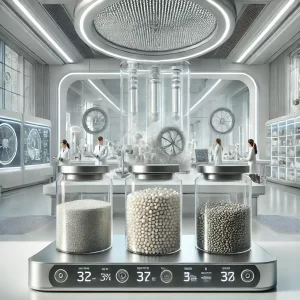
Chitosan, a biopolymer derived from chitin, has been extensively studied for its incorporation into filter media and as a coating, due to its antimicrobial properties. Here are research documents exploring some of these applications:
-
“Removal of Oily Wastewater Using Chitosan-filled Filter Media”: This study investigates the use of chitosan-enriched filter media for treating oily wastewater. The researchers found that incorporating chitosan into filter media enhanced the removal efficiency of suspended solids, oil, grease, and chemical oxygen demand from palm oil mill effluent. The results suggest that chitosan-enriched filter media can effectively address oily wastewater contamination.
-
“Nanostructured Chitosan Membranes for Filtration”: This dissertation explores the development of nanostructured chitosan membranes for filtration applications. The study demonstrates that chitosan-based membranes possess metal-binding and antimicrobial properties, making them suitable for filtering heavy metals and bacteria from waste media. The filtration performance of these membranes was evaluated against various particles, indicating their potential in environmental and medical filtration systems. trace.tennessee.edu
-
“Chitosan Coating in the Form of Polymer and Nanowhiskers on Clothing Fabrics for Improved Particulate Matter Removal Efficiency in Face Mask Filters”: This research examines the application of chitosan coatings on clothing fabrics to enhance their effectiveness as face mask filters. The study reports that chitosan-coated fabrics exhibited improved particulate matter removal efficiency, suggesting that chitosan coatings can enhance the filtration capabilities of face masks.
-
“Stability of Ultraviolet-Cured Chitosan Coating on Cotton Gauze for Biological Disinfection”: This study investigates the stability of chitosan coatings on cotton gauze for biological disinfection purposes. The researchers found that chitosan-coated gauze demonstrated effective antimicrobial properties, indicating that chitosan coatings can be applied to textiles for disinfection applications.
-
Evaluation of the antimicrobial activity of chitosan and its quaternized derivative on E. coli and S. aureus growth
https://www.sciencedirect.com/science/article/pii/S0102695X15002069
Shield Nutraceuticals conducted the following study with the University of Arizona. They tested chitosan oligosaccharide mixed with citric acid (as a protonator) and tested 5 different strains of pathogenic bacteria, including Staphylococcus Aureus (MRSA). The following link is to the Test Results.
These studies collectively highlight the versatility of chitosan in enhancing filter media and coatings, underscoring its potential in environmental and medical applications.
Is chitosan oligosaccharide bacteriostatic or bactericidal?
Chitosan oligosaccharide (COS) can exhibit bacteriostatic and/or bactericidal properties, depending on its concentration, the type of microorganism, and environmental factors.
Key Insights:
- Bacteriostatic Properties
- At lower concentrations, COS often acts as bacteriostatic by inhibiting bacterial growth and reproduction.
- It interferes with:
- The bacterial cell membrane, leading to increased permeability and reduced metabolic activity.
- DNA replication and RNA transcription by binding to bacterial nucleic acids.
- Bactericidal Properties
- At higher concentrations, COS can exhibit bactericidal activity, directly killing bacteria.
- The mechanism involves:
- Disruption of the bacterial cell membrane, causing leakage of intracellular contents and cell death.
- Enhanced production of reactive oxygen species (ROS), leading to oxidative damage.
Factors Influencing Its Mode of Action:
- Degree of Polymerization: COS is a low-molecular-weight derivative of chitosan, and its short chains enable better interaction with bacterial cells, enhancing its antibacterial effects.
- Concentration: Higher concentrations are typically bactericidal, while lower concentrations are bacteriostatic.
- Bacterial Type:
- Gram-positive bacteria (e.g., Staphylococcus aureus): More susceptible due to their thicker peptidoglycan layer that interacts strongly with COS.
- Gram-negative bacteria (e.g., Escherichia coli): May require higher concentrations of COS due to their outer membrane barrier.
- Environmental Conditions: pH, temperature, and ionic strength can alter COS activity. Acidic conditions often enhance its antibacterial effectiveness.
Chitosan oligosaccharide can be bacteriostatic or bactericidal, depending on its usage. It is particularly valued for its biocompatibility, biodegradability, and broad-spectrum antimicrobial activity.
Benefits and Functions of Chitosan in Air Filtration Applications
Antimicrobial Properties
-
-
-
-
Chitosan has inherent antimicrobial properties that effectively reduce bacteria, viruses, and fungi in the air.
-
-
-
-
-
-
-
This is especially beneficial in environments requiring high cleanliness standards, like hospitals and laboratories.
-
-
-
-
-
-
-
Chitosan’s antimicrobial action can enhance the overall hygiene and safety of filtered air.
-
-
-
Improved Filtration Efficiency
-
-
-
-
Adding chitosan to air filter media can improve the capture and removal of particulate matter, including fine particles.
-
-
-
-
-
-
-
Chitosan nanofibers have a high surface area that enhances particle adsorption.
-
-
-
-
-
-
-
Studies show chitosan-based filters can remove up to 99.6% of 300 nm particles, approaching HEPA filter standards.
-
-
-
-
-
-
-
Chitosan’s structural properties enable it to trap smaller particulate matter and pollutants more effectively than some traditional filters, including fine dust, pollen, and other allergens.
-
-
-
Adsorption of Pollutants and Allergens
-
-
-
-
Chitosan’s unique chemical structure allows it to adsorb various air pollutants and common allergens.
-
-
-
-
-
-
-
This improves overall air quality by reducing irritants and potentially harmful substances.
-
-
-
Biodegradability and Non-Toxicity
-
-
-
-
As a natural biopolymer, chitosan is non-toxic and biodegradable.
-
-
-
-
-
-
-
Using chitosan in air filters reduces the environmental impact compared to synthetic materials.
-
-
-
-
-
-
-
Mushroom chitosan in particular is considered hypoallergenic and safe for those with shellfish allergies.
-
-
-
-
-
-
-
Chitosan can be incorporated into various air filtration products, including HVAC filters, cabin air filters, air purifiers, and face masks.
-
-
-
-
-
-
-
It can be applied as a coating or blended into filter media.
-
-
-
-
-
-
-
Low concentrations of 0.5-3% chitosan by weight are typically sufficient to kill pathogens.
-
-
-

Healthcare Facilities (Commercial Kitchens, Patient Areas)
Applications:
-
Capturing and eliminating microbes and contaminants
-
Reducing the risk of airborne diseases
Products:
-
Antimicrobial air filters for HVAC systems
-
Portable air purifiers for patient rooms and common areas
Chitosan addition ratio: 1-5% by weight of filter media for high microbial reduction efficiency
Industrial Settings
Applications:
-
Removing volatile organic compounds (VOCs) and other chemical pollutants
-
Enhancing overall air quality in manufacturing environments
Products:
-
Industrial-grade air filtration systems
-
Chemical fume hoods with enhanced filters
Chitosan addition ratio: 2-7% depending on the specific pollutants targeted
Residential Air Purification
Applications:
-
Allergen reduction
-
Removal of household odors and pollutants
Products:
-
Home air purifiers with enhanced filtration capabilities
-
HVAC filters for central air systems
Chitosan addition ratio: 1-3% for general household use

-
Improving air quality in vehicles, airplanes, and public transit systems
-
Reducing the spread of airborne pathogens in enclosed spaces
Products:
-
Cabin air filters for automobiles and aircraft
-
Air purification systems for public transportation
Chitosan addition ratio: 2-5% for enhanced pathogen capture in confined spaces
Commercial Buildings
Applications:
-
Maintaining indoor air quality in offices, schools, and public spaces
-
Reducing the spread of airborne contaminants in high-traffic areas
Products:
-
Commercial-grade HVAC filters
-
Standalone air purification units for large spaces
Chitosan addition ratio: 1-4% for balanced filtration and air flow in large-scale systems
Food Industry
Applications:
-
Controlling airborne contaminants in food processing facilities
-
Extending the shelf life of perishable products
Products:
-
Specialized air filtration systems for food production areas
-
Storage area air purifiers
Chitosan addition ratio: 3-6% for high-efficiency microbial control in food-safe environmentsThe incorporation of mushroom chitosan in these air filtration products can significantly enhance their performance, particularly in terms of antimicrobial efficacy, chemical contaminant removal, and overall filtration efficiency. As research continues, we may see even more innovative applications leveraging the unique properties of vegetal chitosan in air purification systems.


Application: High-Efficiency Particulate Air (HEPA) filters used in environments demanding ultra-clean air.
Benefit: Chitosan enhances these filters with antimicrobial properties, making them more effective at eliminating microbes.
Products:
-
Enhanced HEPA filters for cleanrooms
-
Antimicrobial HEPA filters for medical facilities
Laminar Air Flow Units
Application: Used in sterile environments to maintain ultra-clean conditions.
Benefit: Ensures a continuous flow of clean air, crucial for sensitive operations.
Products:
-
Laminar flow cabinets with chitosan-enhanced filters
-
Vertical laminar flow units for pharmaceutical manufacturing
Clean Rooms and Laboratories
Applications:
-
Semiconductor manufacturing
-
Biotech laboratories
-
Pharmaceutical production
Benefits:
-
High filtration efficiency
-
Enhanced antimicrobial properties
-
Maintenance of stringent cleanliness standards
Products:
-
Specialized air handling units with chitosan-treated filters
-
Portable clean air modules for modular cleanroom setups
Chitosan Addition Ratio
For applications requiring high efficiency in microbial reduction, chitosan might be used in concentrations ranging from 1% to 5% by weight of the filter media. This concentration is sufficient to impart antimicrobial properties without compromising air flow or filter integrity.
Additional Considerations
-
Customization: The exact chitosan concentration can be tailored to specific industry requirements and cleanliness standards.
-
Compatibility: Ensure chitosan treatments are compatible with existing cleanroom protocols and materials.
-
Validation: Regular testing and validation of air quality to confirm the effectiveness of chitosan-enhanced filtration systems.
-
Regulatory Compliance: Adherence to industry-specific regulations and standards for air quality in controlled environments.
By integrating chitosan into these specialized air filtration products, facilities can achieve superior air quality, essential for maintaining the stringent cleanliness standards required in high-tech and sensitive environments. The antimicrobial properties of chitosan provide an additional layer of protection against contaminants, making it particularly valuable in industries where even microscopic impurities can have significant consequences.

Industrial Air Filtration with Chitosan
In industrial settings, air filtration systems face unique challenges due to the variety and concentration of contaminants present. Chitosan’s ability to chemically bind with various toxic substances makes it an excellent choice for industrial air purification systems.
Applications and Products
1. Industrial Air Handlers
Application: Large-scale air filtration systems used in manufacturing and processing plants.
Benefit: Chitosan enhancement improves the removal of chemical pollutants and fine particulates, leading to cleaner air in industrial environments.
Implementation:
-
Chitosan can be incorporated into filter media or applied as a coating.
-
These enhanced filters can be installed in existing air handling units to upgrade their performance.
2. Dust Collection Systems
Application: Systems designed to capture fine particulates generated during industrial processes.
Benefit: Chitosan enhances filtration efficiency, making these systems more effective at handling industrial dust and debris.
Implementation:
-
Chitosan-enhanced filter bags or cartridges can be used in baghouse systems.
-
Cyclone separators can be equipped with chitosan-treated secondary filters for improved fine particle capture.
Chitosan Addition Ratio
In industrial settings where filters need to handle a higher load of chemical pollutants:
-
The concentration of chitosan typically ranges from 2% to 5% by weight of the filter media.
-
The exact percentage can vary based on:
-
Specific chemicals present in the environment
-
Volume of air being processed
-
Desired filtration efficiency
-
Customization: The chitosan concentration can be adjusted based on air quality assessments and specific industry requirements.
Benefits of Incorporating Chitosan
-
Enhanced Chemical Pollutant Removal: Chitosan’s ability to chemically bind with toxic substances improves the capture of industrial vapors and gases.
-
Improved Particulate Filtration: The high surface area of chitosan nanofibers enhances the capture of fine dust and particulates.
-
Antimicrobial Properties: Chitosan’s inherent antimicrobial nature helps prevent the growth of bacteria and fungi on filter surfaces.
-
Environmentally Friendly: As a biodegradable material, chitosan aligns with sustainable industrial practices.
-
Cost-Effective: Improved filtration efficiency can lead to longer filter life and reduced maintenance costs.
By incorporating chitosan into industrial air filtration products, facilities can achieve more effective purification, ensuring a safer and cleaner working environment. This advanced filtration approach not only improves air quality but also contributes to better occupational health and safety standards in industrial settings.

Air Purifiers with Chitosan-impregnated Filters
Portable or standalone air purifiers equipped with chitosan filters offer an effective solution for maintaining and improving air quality in homes, offices, and other enclosed spaces, especially in areas with limited ventilation. These devices can significantly enhance indoor air quality by removing pollutants, allergens, and potentially harmful microorganisms.
Applications and Products
1. Stand-alone Air Purifiers
Description: Larger units that often feature multiple filter stages, with chitosan filters as a key component.Usage: Ideal for homes, offices, and larger enclosed spaces.Benefits:
-
Provide comprehensive air purification
-
Target a wide range of pollutants and allergens
-
Suitable for larger areas
2. Desktop and Personal Air Purifiers
Description: Smaller, more compact devices designed for individual use.Usage: Suitable for placing on workstations, bedside tables, or other personal spaces.Benefits:
-
Offer localized air purification
-
Improve air quality in the immediate vicinity of the user
-
Portable and convenient for personal use
Chitosan Addition Ratio
For these portable air purifiers, the chitosan concentration typically ranges from 0.5% to 3% by weight of the filter media. This ratio is carefully determined based on:
-
The level of air purification required
-
Specific pollutants targeted in the environment
-
The need to maintain efficient airflow through the device
Benefits of Chitosan-Enhanced Air Purifiers
-
Effective Pollutant Removal: Chitosan’s unique chemical structure allows it to adsorb various air pollutants and common allergens.
-
Antimicrobial Properties: Chitosan’s inherent antimicrobial nature helps reduce bacteria, viruses, and fungi in the air.
-
Improved Indoor Air Quality: These devices can significantly enhance air quality by removing irritants and potentially harmful substances.
-
Environmentally Friendly: As a natural biopolymer, chitosan is biodegradable and non-toxic, aligning with eco-friendly practices.
-
Versatility: Suitable for various indoor environments, from residential spaces to offices and commercial settings.
-
Customizable Performance: The chitosan concentration can be adjusted to target specific pollutants or meet particular air quality requirements.
By incorporating chitosan at these concentrations, manufacturers can create air purifiers that effectively remove a wide range of airborne contaminants while maintaining optimal performance. These devices are particularly valuable in urban environments or for individuals with respiratory sensitivities, offering a practical solution for improving indoor air quality in various settings.

Chitosan’s antimicrobial properties can be leveraged in these environments to reduce the spread of mold, bacteria, and other harmful organisms, thereby ensuring better preservation and safety of food products.
Applications and Products
-
Ventilation Filters for Controlled Environments:
-
Description: Used in greenhouses or storage areas to prevent the growth of mold and bacteria on organic products.
-
Benefit: Maintains a clean environment, protecting food products from microbial contamination.
-
-
Air Scrubbers:
-
Description: Devices used to remove airborne contaminants in food processing areas.
-
Benefit: Ensures the air remains clean and free of pathogens, enhancing food safety.
-
Chitosan Addition Ratio
In these environments, higher concentrations of chitosan are typically used:
-
Range: 3% to 5% by weight of the filter media
-
Purpose: To maximize antimicrobial effectiveness
-
Benefit: Ensures robust protection against mold and bacteria in more sensitive settings
By incorporating chitosan at these concentrations, manufacturers can create ventilation filters and air scrubbers that provide superior microbial control. This enhancement significantly improves the preservation and safety of food products in controlled environments.
Additional Benefits
-
Extended shelf life of produce and food products
-
Reduced risk of foodborne illnesses
-
Improved overall air quality in agricultural and food processing facilities
-
Potential reduction in the use of chemical preservatives
Checklist
-
Regular monitoring and replacement of filters may be necessary to maintain optimal performance.
-
The specific chitosan concentration may need to be adjusted based on the particular needs of each facility and the types of products being handled.
-
Compatibility with existing ventilation systems should be ensured before implementation.

The common forms of chitosan used in air filtration:
- Powder
- Description: Finely ground chitosan
- Applications: Used as a coating on filter media in HVAC filters, HEPA filters, and air purifiers
- Benefits: Enhances antimicrobial and particulate-capturing properties
- Usage: Typically blended with other filter media or applied as a coating
- Nanofibers
- Description: Extremely thin fibers of chitosan produced through electrospinning
- Applications: Used in high-efficiency air filters and face masks
- Benefits: Provides high surface area for improved filtration efficiency
- Usage: Often combined with other polymers to create composite nanofiber membranes
- Solutions/Coatings
- Description: Liquid form of chitosan dissolved in mild acid
- Applications: Used to treat existing filter media or create new filter materials
- Benefits: Allows for even distribution of chitosan across filter surfaces
- Usage: Applied through dipping, spraying or other coating methods
- Composite Materials
- Description: Chitosan combined with other materials like cellulose or synthetic polymers
- Applications: Used in various air filtration products
- Benefits: Combines properties of chitosan with other materials for enhanced performance
- Usage: Formed into filter media through various manufacturing processes
- Hydrogels
- Description: Water-swollen networks of chitosan polymers
- Applications: Used in specialized air filtration systems, especially for capturing VOCs
- Benefits: High adsorption capacity for certain pollutants
- Usage: Incorporated into filter designs that can accommodate gel-like materials
- Microparticles
- Description: Small particles of chitosan, larger than nanoparticles but still microscopic
- Applications: Used in filter media for capturing larger particulates
- Benefits: Provides good balance of filtration efficiency and air flow
- Usage: Often incorporated into fibrous filter materials
The choice of form depends on the specific application, desired properties, and manufacturing process of the air filtration product. Manufacturers may use different forms or combinations to achieve optimal performance in their filtration systems.


- Membranes
- Description: Customizable thin films or sheets made from chitosan
- Applications: Used in advanced air cleaning and purification systems, such as in clean rooms or labs
- Benefits: Efficient filtration, can be used stand-alone or integrated into composite filter membranes
- Usage: Often employed where high-performance filtration is necessary
- Beads or Granules
- Description: Small, spherical particles of chitosan
- Applications: Commonly used in air scrubbers and industrial filters
- Benefits: Allows for controlled airflow and efficient contaminant capture
- Usage: Effective at adsorbing chemical pollutants or removing airborne pathogens

Summary of Chitosan’s Use in Air Filtration Applications
Chitosan represents a significant advancement in air filtration technology, offering several key benefits:
- Effective Particulate Capture
- Unique molecular structure efficiently traps fine particulates
- Improves overall air quality
- Antimicrobial Properties
- Imparts natural antimicrobial characteristics to filtration media
- Reduces the presence of harmful microorganisms in the air
- Eco-Friendly Solution
- Biodegradable material aligns with sustainability goals
- Enhances air purification without contributing to long-term waste
- Versatile Application
- Can be integrated into various air filtration systems:
- Residential HVAC units
- Commercial air purifiers
- Healthcare facility ventilation systems
- Can be integrated into various air filtration systems:
- Comprehensive Air Cleaning
- Superior performance in removing a wide range of air contaminants:
- Pollutants
- Allergens
- Pathogens
- Superior performance in removing a wide range of air contaminants:
By incorporating chitosan into air filtration systems, manufacturers can create more effective, environmentally responsible solutions for cleaner and healthier indoor air environments. This innovative material addresses modern air quality challenges while supporting sustainable practices, representing a significant step forward in air filtration technology.

The versatility of chitosan in air filtration applications is truly remarkable, offering a wide range of formulations that can be tailored to specific filtration needs. This adaptability is evident in the various forms and derivatives available, each providing unique benefits for different air purification scenarios.
Future Potential
Chitosan is poised to play a pivotal role in shaping the future of air filtration:
- Offers environmentally friendly solutions without compromising on performance
- Can be customized for various applications, from residential air purifiers to industrial-scale systems
- Addresses diverse air quality challenges across different sectors
By leveraging the unique properties of chitosan, manufacturers can create innovative air filtration solutions that are both effective and sustainable, meeting the growing demand for advanced air purification technologies in an environmentally conscious world.
We offer an initial 30-minute consultation and product quotation at no charge.
